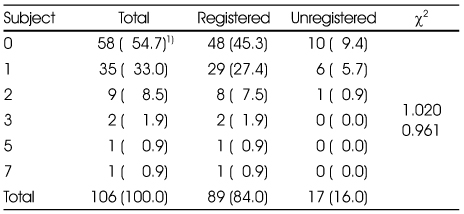The Current State of Food Allergy of Preschool Childcare Facilities in Hanam
Article information
Abstract
Objectives
The purpose of this study was to investigate how to manage food allergy of pre-school children, focusing on the current status of the food allergy in childcare facilities in Hanam which have less than 100 children.
Methods
Targeting 159 preschool childcare facilities, survey was carried out for a month in March, 2015. Recovery rate was 66.7%. 106 surveys out of 159 were available for analysis using SPSS statistical program version 19.0.
Results
Among 106 facilities, 58 (54.7%) reported that none of their children had a food allergy and 48 (45.3%) reported one more children had a food allergy. Total number of children having a food allergy was 71. Among them, the occurrences of food allergy in males were significantly more than that of the females (p < 0.001). Further, children under 2 years of age had significantly more food allergy than the other ages (p < 0.001). The allergic inducing foods were nuts (23.3%), egg (17.8%), milk and dairy products (16.4%), fish and shellfish (13.7%), instant foods (12.3%), fruits (8.2%), soybean (4.1%), meat (2.7%), and cereals (1.4%) in order, and 6 children out of 71 were allergic to more than 2 food items. The clinical symptoms of the food allergy were a skin reaction (87.9%) and an oropharyngeal & respiratory reaction (12.1%). Majority of childcare facilities (80.3%) didn't serve alternative foods for children with food allergy. Necessity for food allergy education was significantly higher in facilities with food allergy issues than without such issues.
Conclusions
The Center for Children's Foodservice Management need to educate workers of childcare facilities and parents about managing food allergy and enforce a plan to provide alternative menu to children with food allergies.






